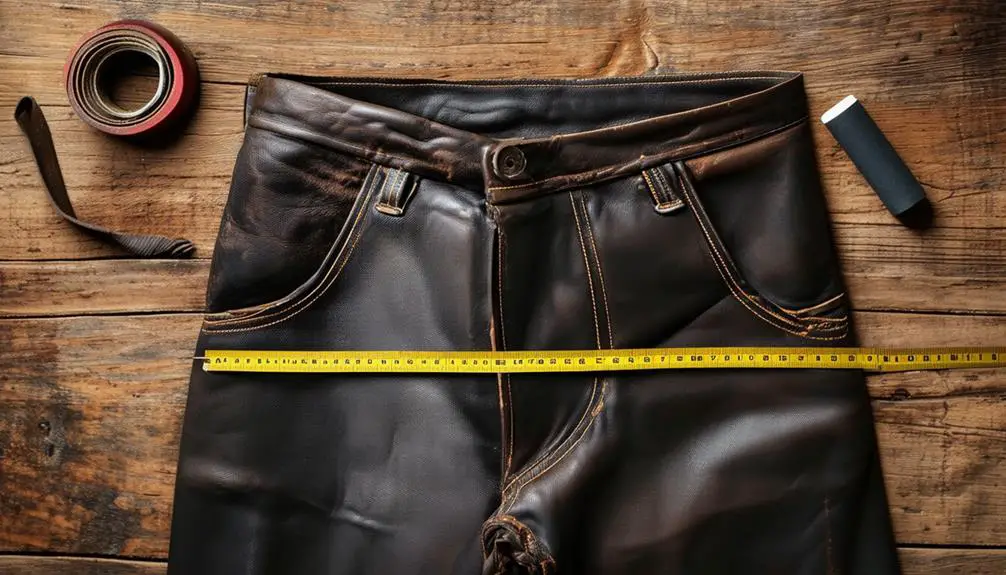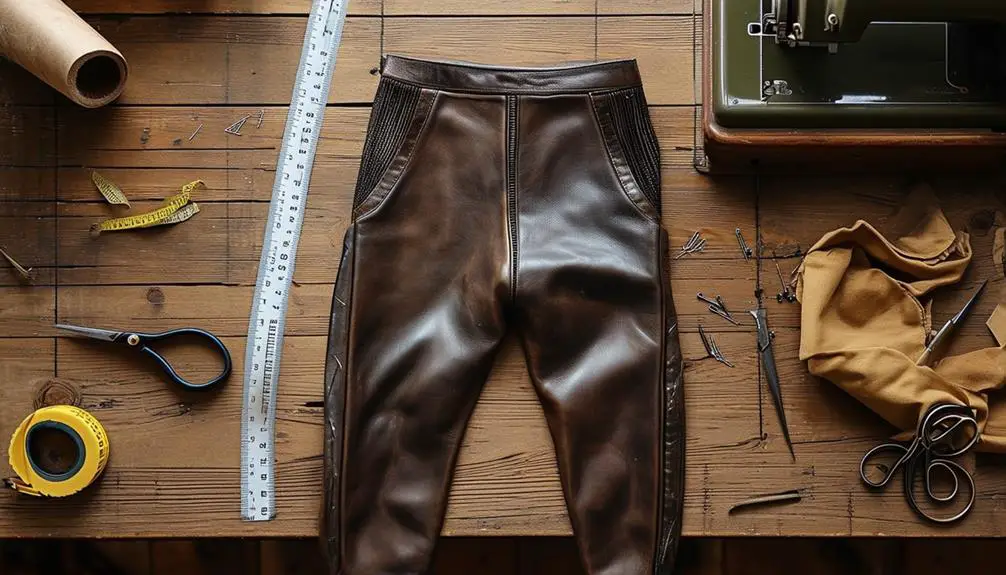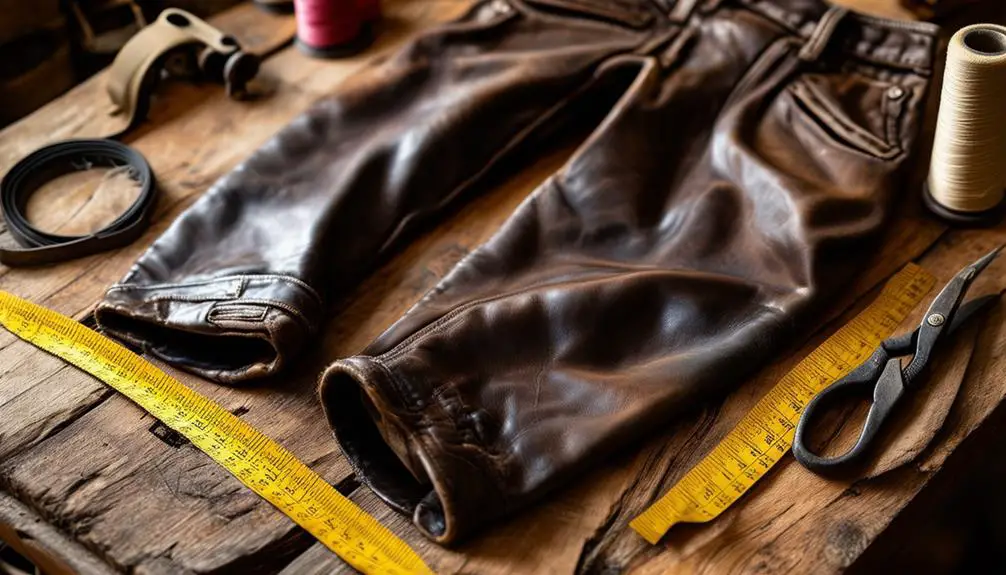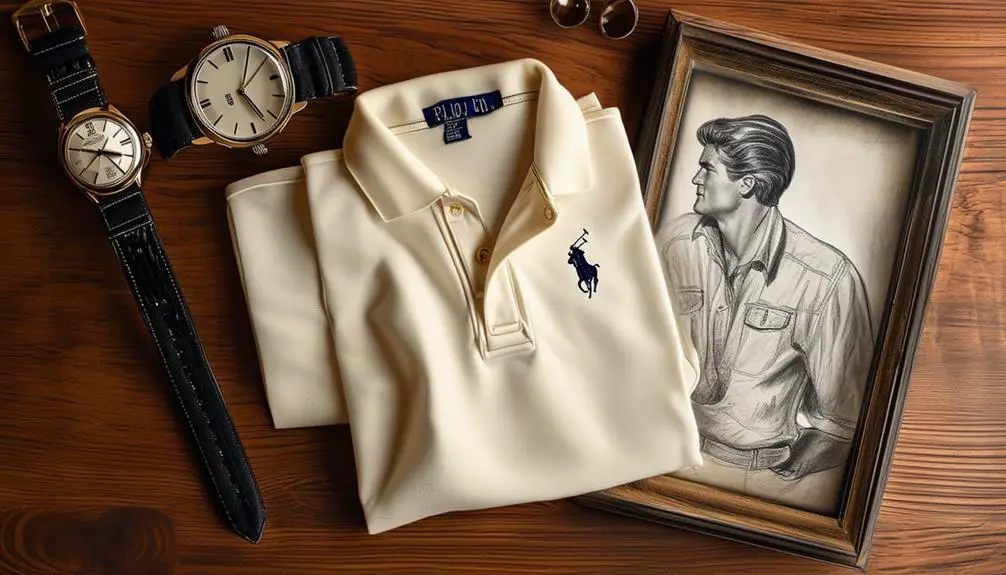To tailor vintage leather trousers, start by wearing them for a few hours to assess comfort and fit. Take precise measurements of your waist, hips, inseam, and thigh circumference. Mark any adjustments needed with masking tape, guaranteeing you leave extra for future alterations. When you're ready, use a leather needle and a heavy-duty sewing machine for the job. If you find the task overwhelming, consider consulting a professional tailor experienced in leather. This guarantees your beloved trousers keep their unique charm while fitting perfectly. There's more to discover about achieving that flawless look!
Assessing Fit and Measurements

How can you guarantee that your vintage leather trousers fit just right? Start by wearing them for a few hours. This will help you gauge comfort and pinpoint areas needing adjustment, like the waist or inseam.
As you wear them, pay attention to how the leather feels against your skin; it may stretch or relax in certain areas. Understanding the historical context of vintage clothing can also inform your tailoring decisions, as certain brands may have unique characteristics reflective of their era, such as stitching techniques or fabric types vintage clothing characteristics.
Next, grab a tape measure and take precise measurements of your waist, hips, inseam, and thigh circumference. Make certain the tape is snug but not compressing the leather.
Compare these measurements to the current fit of your trousers. Noticing discrepancies, such as a tighter waist or longer inseam, will guide your tailoring leather process.
Additionally, assess any leather-specific characteristics, like stretchability, which can influence how the trousers fit after initial wear. Document your findings and desired changes clearly, so you can communicate effectively with a professional tailor or use them for DIY alterations.
Taking these steps will guarantee your vintage leather trousers not only look great but also feel fantastic, giving you that perfect fit you've been after.
Tools and Techniques Needed
When it comes to tailoring vintage leather trousers, having the right tools on hand can make all the difference. First, you'll need a leather needle, which is specifically designed to handle the thickness of leather pants. Pair this with a specialized heavy-duty sewing machine, or at least a robust needle and thread, to guarantee your stitches hold strong.
Next, masking tape is invaluable for marking adjustments without damaging the leather. For hemming, traditional stitching can fail, so grab some rubber cement or a strong adhesive to secure your hems effectively. A steel plate under the sewing machine foot can also help prevent needle breakage and keep your sewing smooth.
Accurate measurements are key, so use a ruler along with chalk or fabric-safe markers to make precise markings. This guarantees your cuts are exact and the fit is just right.
Speaking of cuts, a pair of sharp scissors designed for leather is essential for achieving clean edges and preventing fraying. With these tools, you'll be well-equipped to transform your vintage leather trousers into a perfect fit!
Step-by-Step Alteration Process

With your tools gathered and ready, you can now commence on the step-by-step alteration process for your vintage leather trousers. Start by measuring the waist, inseam, and overall length to pinpoint the adjustments needed for a perfect fit.
Next, use masking tape to mark any cutting areas. Avoid pins, as they can damage the leather; instead, cut slowly and carefully to maintain the integrity of the fabric.
If you need to alter the waist, consider adding or removing panels, or use a leather needle and thread for adjustments, making sure you reinforce seams for durability.
When it's time to hem, leave an additional 1.5 inches for future adjustments. If you prefer adhesive methods, opt for rubber cement, applying it with a leather needle for a secure bond.
After each adjustment, always test the fit by wearing the trousers for a few hours. This helps you verify comfort and catch any surprises with stretching or fit changes.
Common Challenges and Solutions
Tailoring vintage leather trousers can present a unique set of challenges that require patience and careful handling. One major hurdle is adjusting the waist and inseam. Leather pants tend to stretch and retain their shape, so precise measurements are essential. You might want to seek professional help for these adjustments to avoid compromising the fit.
Another challenge lies in the intricate details, like zippers and flaps, which can hinder alterations. To tackle this, use specialized tools such as leather needles and adhesive methods. These can help you minimize damage during the process.
When it comes to adjusting the length, traditional pinning methods can puncture the leather. Instead, consider using masking tape to mark your desired lengths; this way, you can avoid any unwanted holes.
Hemming vintage leather trousers can also be tricky. Instead of sewing, you can use non-permanent adhesives like rubber cement or double-sided tape. This approach allows you to make adjustments without committing to a permanent alteration, giving you the flexibility to change your mind later.
Cost Considerations for Tailoring

Adjustments to vintage leather trousers can come with a hefty price tag, so it's wise to contemplate the costs involved before proceeding.
Tailoring leather pants typically ranges from $85 to $250, depending on how intricate the alterations are. If you're simply adjusting the waist or length, expect to pay towards the lower end of that scale. However, more complex modifications can push those numbers up considerably.
Keep in mind that leather requires specialized skills, making alterations pricier than for standard fabrics. The tailor's expertise and your geographical location can further influence pricing.
For instance, a basic hem alteration might start around $100, which already nudges you towards the higher end of typical garment adjustments.
Before committing to tailoring, evaluate the cost-effectiveness. Sometimes, the expense of altering vintage leather trousers can rival or even exceed the price of purchasing new ones.
It's essential to weigh your options carefully. While it's tempting to revamp those beloved leather pants, financial considerations should guide your decision, ensuring you're making a savvy investment in your wardrobe.
Seeking Professional Assistance
Finding the right professional to tailor your vintage leather trousers can make all the difference in achieving the perfect fit. Leather is a unique material that requires specialized skills and tools, making it crucial to seek out someone with experience in leather alterations. Not all tailors are equipped to handle the complexities of leather, and you want to avoid costly mistakes that could ruin your treasured trousers.
When searching for a tailor, look for one who specifically lists leather alteration services. Many may only offer basic adjustments like waist alterations or hemming, so be clear about your needs. Their fees typically range from $85 to $250, depending on the complexity of the work. This investment is worthwhile for the professional touch that guarantees your vintage leather retains its integrity while achieving the desired fit.
Consulting a qualified leather tailor not only enhances the fit but also preserves the unique character of your trousers. By taking the time to find the right expert, you'll guarantee your vintage leather trousers look fabulous and feel comfortable for years to come.
Frequently Asked Questions
Can Leather Trousers Be Altered?
Yes, you can alter leather trousers. Depending on the type of leather, adjustments like waist and length changes are possible. However, making them larger is tricky, so professional help's often the best route for complex alterations.
How Do You Fix Leather Pants That Are Too Big?
To fix oversized leather pants, you'll want to take them in at the waist. Consult a skilled leather tailor, avoid pins, and use masking tape instead. Remember, leather stretches over time, so wear them afterward!
How to Shorten Leather Look Trousers?
To shorten leather look trousers, mark your desired length with chalk, leaving extra for hemming. Use a leather needle or adhesive for clean edges, avoiding traditional stitching to keep the fabric intact and stylish.
Can Leather Clothing Be Tailored?
Yes, you can tailor leather clothing, but it requires specialized skills. You'll want to consult a professional who understands the material's nuances, ensuring your alterations maintain the leather's integrity and style without damage.





I don’t think the title of your article matches the content lol. Just kidding, mainly because I had some doubts after reading the article. https://accounts.binance.com/zh-CN/register?ref=VDVEQ78S
Your point of view caught my eye and was very interesting. Thanks. I have a question for you.